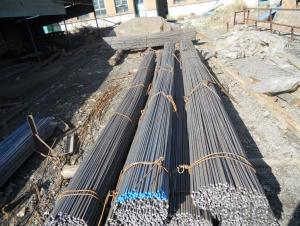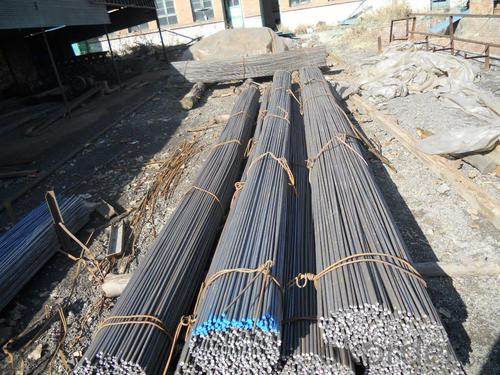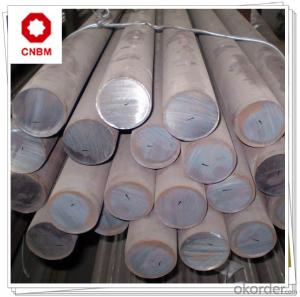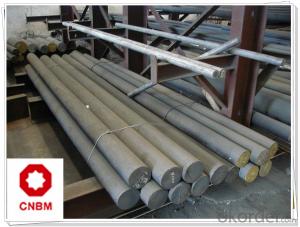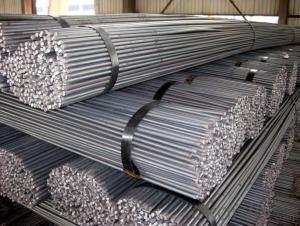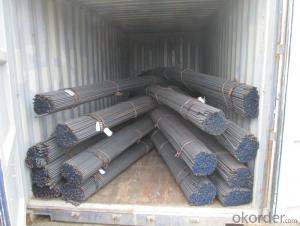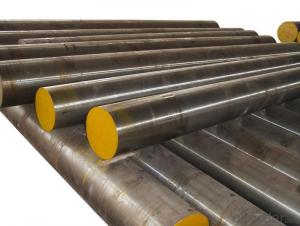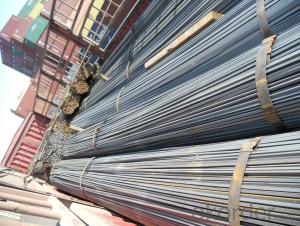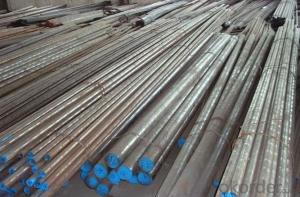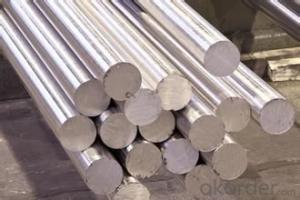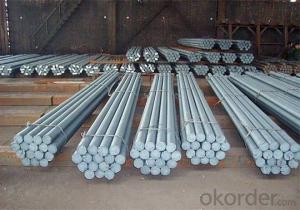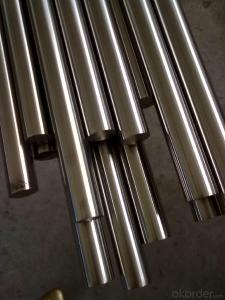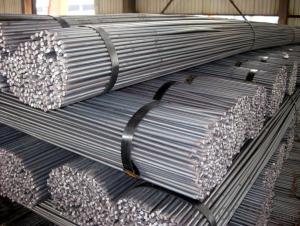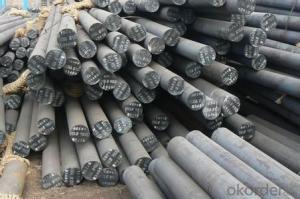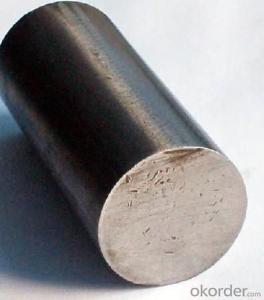High Quality Steel Round Bar Q235, A36, SS400
- Loading Port:
- Lianyungang
- Payment Terms:
- TT OR LC
- Min Order Qty:
- 25 m.t.
- Supply Capability:
- 200000 m.t./month
OKorder Service Pledge
OKorder Financial Service
You Might Also Like
Specifications of High Quality Steel Round Bar Q235, A36, SS400
1. Grade: GB, JIS, ASTM, EN
2. Grade: Q235, SS400, A36, S235JR
3. Diameter and mass: As below
Diameter | Mass | Diameter | Mass | Diameter | Mass |
(mm) | (kg/m) | (mm) | (kg/m) | (mm) | (kg/m) |
6 | 0.22 | 22 | 2.98 | 53 | 17.30 |
7 | 0.30 | 24 | 3.55 | 56 | 19.30 |
8 | 0.40 | 25 | 3.85 | 60 | 22.20 |
9 | 0.50 | 26 | 4.17 | 63 | 24.50 |
10 | 0.62 | 28 | 4.83 | 65 | 26.00 |
11 | 0.75 | 30 | 5.55 | 70 | 30.20 |
12 | 0.89 | 32 | 6.31 | 75 | 34.70 |
13 | 1.04 | 34 | 7.13 | 80 | 39.50 |
14 | 1.21 | 36 | 7.99 | 85 | 44.50 |
15 | 1.39 | 38 | 8.90 | 90 | 49.90 |
16 | 1.58 | 40 | 9.86 | 95 | 55.60 |
17 | 1.78 | 42 | 10.90 | 100 | 61.70 |
18 | 2.00 | 45 | 12.50 | 120 | 88.85 |
19 | 2.23 | 48 | 14.20 | 140 | 120.93 |
20 | 2.47 | 50 | 15.40 | 150 | 138.82 |
4. Material: Mild Steel
5. Heat treatment of high quality steel:
Fire: Isothermal annealing temperature is 800 ~ 880 °C, with 10 ~ 20 °C, the furnace cooling to about 600 °C, hardness above HB269.
Preheat temperature: 730-730 °C
Quenching temperature: 1190-1210 °C
Tempering temperature: 540-595 °C
Cold drawn, hardness 285 HBS
Cold drawn after annealing condition, hardness 277 HBS
Quenching methods: oil quenching, air cooling or salt bath quenching
Usage and Applications of High Quality Steel Round Bar Q235, A36, SS400
1) Suitable for making various strong cutting tool abrasion resistance, impact resistance.
2) Used to produce all kinds of high hard and super hard saw blade, drill, tap, broach, gear hob and various kinds of milling cutter.
3) Used for advanced punching die, screw die, and the toughness and complicated shape of the punch, etc.
4) Is used for cold forging die and drawing mode, etc.
5) Recommended watchcase factory, screw factory and other cold stamping products industry use.
Packaging & Delivery of High Quality Steel Round Bar Q235, A36, SS400
Packaging Detail: All goods are packed in bundle with steel strips and shipped by break bulk vessel or container (depend on target market and different ports)
Delivery Detail: 45 days
Trade terms: FOB, CFR, CIF
MOQ: 25 tons per specification; we can negotiate the quantity if the specification is normal or we have stock of one specification.
Weight: The price invoicing on theoretical weight basis or actual weight basis depends on customer’s request.
Shipment: The shipment of bulk break or container is depends on customer’s request and the situation of the port of destination.
Documents given: Full set of original clean on board bill of lading; Original signed commercial invoice; Original packing list; Policy of insurance; Certificate of origin and what the target market needs.
Production Flow of High Quality Steel Round Bar Q235, A36, SS400
The common processes are preheated forging quenching, dual refinement solution process, cooling quenching and isothermal quenching. We use heat treatment for dual refinement solution process. The main measures process is high temperature solution and refinement cycle. High temperature solution can improve the carbide morphology and particle size. The aim is to make the loop refinement ultrafine austenite grains.
- Q: How do steel round bars perform in high-pressure applications?
- Steel round bars are known for their exceptional strength and durability, making them highly suitable for high-pressure applications. When subjected to high-pressure conditions, steel round bars exhibit excellent resistance to deformation and maintain their structural integrity. This enables them to withstand the intense forces and maintain their shape, ensuring the safety and reliability of the application. Steel round bars are often used in high-pressure applications such as hydraulic systems, oil and gas pipelines, aerospace components, and high-pressure vessels. Their robust nature allows them to handle the extreme pressures experienced in these applications without failure. The high tensile strength of steel ensures that the bars do not buckle or collapse under pressure, providing the necessary support and stability required for such demanding environments. Additionally, steel round bars possess excellent corrosion resistance properties, which is crucial in high-pressure applications. They can withstand exposure to harsh chemicals, moisture, and other corrosive elements, preventing rusting or degradation over time. This corrosion resistance ensures the longevity and reliability of the steel round bars in high-pressure environments, reducing the risk of premature failure. Furthermore, steel round bars offer versatility in terms of grades and alloys, allowing for customization to meet specific high-pressure requirements. Different grades of steel, such as carbon steel, alloy steel, or stainless steel, can be utilized based on the application's demands. This versatility ensures that the steel round bars can be tailored to provide optimal performance and meet the specific pressure and temperature requirements of the application. In conclusion, steel round bars excel in high-pressure applications due to their exceptional strength, durability, and corrosion resistance properties. Their ability to withstand intense forces and maintain their shape makes them a reliable choice for various industries, including hydraulic systems, oil and gas pipelines, aerospace, and high-pressure vessels. By utilizing steel round bars, companies can ensure the safety, reliability, and longevity of their high-pressure applications.
- Q: What are the different types of steel round bar surface treatments used in the aerospace industry?
- In the aerospace industry, there are several types of steel round bar surface treatments that are commonly used to enhance the performance and durability of the materials. These treatments are specifically designed to meet the stringent requirements and standards set by the industry. Some of the different types of steel round bar surface treatments used in the aerospace industry include: 1. Passivation: This treatment involves the removal of iron particles and other contaminants from the surface of the steel round bar. It helps to prevent corrosion and improves the overall corrosion resistance properties of the material. 2. Shot Peening: Shot peening is a process that involves bombarding the surface of the steel round bar with small metallic shots. This treatment induces compressive stress on the surface, which enhances the material's fatigue strength and resistance to stress corrosion cracking. 3. Electroplating: Electroplating is a common surface treatment used in the aerospace industry. It involves the deposition of a layer of metallic coating onto the steel round bar through an electrochemical process. This treatment enhances the material's corrosion resistance, wear resistance, and aesthetic appearance. 4. Anodizing: Anodizing is an electrolytic passivation process that is commonly used on aluminum alloys. However, it can also be used on steel round bars. This treatment forms a thick, durable, and corrosion-resistant layer of oxide on the surface, which improves the material's resistance to wear, corrosion, and scratching. 5. Nitriding: Nitriding is a surface hardening treatment that involves the diffusion of nitrogen into the surface of the steel round bar. This treatment improves the material's surface hardness, wear resistance, and fatigue strength. 6. Chemical Conversion Coating: Chemical conversion coating is a treatment that involves the formation of a thin, protective layer on the surface of the steel round bar. This coating enhances the material's corrosion resistance and provides a good base for subsequent paint or coating applications. These are just a few examples of the different types of steel round bar surface treatments used in the aerospace industry. Each treatment offers unique benefits and is selected based on the specific requirements of the application, such as corrosion resistance, wear resistance, fatigue strength, and aesthetic appearance.
- Q: What are the different types of steel round bar alloys for improved toughness and wear resistance?
- There are several different types of steel round bar alloys that are known for improved toughness and wear resistance. Some of these alloys include tool steel, stainless steel, alloy steel, and carbon steel. Each of these alloys has unique properties and compositions that make them suitable for various applications where toughness and wear resistance are crucial.
- Q: Can steel round bars be used in the production of packaging equipment?
- Steel round bars are indeed a versatile option for the production of packaging equipment. Their exceptional strength and durability make them highly favored in various industries. When it comes to packaging equipment, these round bars serve multiple purposes, such as offering structural support, reinforcement, or acting as components in the machinery's moving parts. The steel's impressive hardness and resistance to wear and tear make it ideal for handling heavy loads and ensuring uninterrupted operation. Moreover, steel round bars can be easily machined, welded, or modified to precisely meet the specific requirements of the packaging equipment. All in all, steel round bars are a dependable and widely utilized material in the manufacturing of packaging equipment.
- Q: What are the different types of steel round bar surface finishes for corrosion resistance?
- There are several different types of steel round bar surface finishes that are commonly used for corrosion resistance. These finishes provide a protective coating on the surface of the bar, preventing contact with corrosive elements and reducing the risk of rusting or degradation over time. One of the most popular finishes for corrosion resistance is hot-dip galvanizing. This involves immersing the steel round bar in a bath of molten zinc, which forms a layer of zinc coating on the surface. The zinc acts as a sacrificial anode, corroding before the steel does, and providing long-lasting protection against rust and corrosion. Another common surface finish for corrosion resistance is stainless steel. This type of steel contains a minimum of 10.5% chromium, which forms a passive oxide layer on the surface when exposed to oxygen. This layer acts as a barrier, preventing further oxidation and corrosion, making stainless steel round bars highly resistant to rust and other forms of corrosion. Electroplating is another method used to provide corrosion resistance to steel round bars. This process involves immersing the bar in an electrolyte solution and passing an electric current through it. This causes a layer of metal, such as zinc or nickel, to be deposited onto the surface of the bar, providing a protective coating. Powder coating is a popular choice for steel round bars that require both corrosion resistance and aesthetic appeal. This process involves applying a dry powder coating to the surface of the bar and then curing it under heat. The powder melts and forms a hard, durable finish that provides excellent corrosion resistance while also offering a wide range of color options. Additionally, there are specialized coatings available for specific applications, such as epoxy coatings or polymer coatings. These coatings are designed to provide superior resistance to certain corrosive environments, such as exposure to chemicals or high humidity. In summary, the different types of steel round bar surface finishes for corrosion resistance include hot-dip galvanizing, stainless steel, electroplating, powder coating, and specialized coatings. Each of these finishes offers varying levels of protection against rust and corrosion, and the choice of finish depends on factors such as the specific application, environmental conditions, and desired aesthetics.
- Q: Can steel round bars be used for making tie rods?
- Yes, steel round bars can be used for making tie rods.
- Q: How are steel round bars used in the manufacturing of valves and fittings?
- Steel round bars are commonly used in the manufacturing of valves and fittings due to their strength, durability, and versatility. These round bars serve as the primary raw material for various components of valves and fittings. One crucial application of steel round bars in valve manufacturing is the production of valve stems. Valve stems are responsible for controlling the flow of fluids or gases through the valve. The round bars are machined and threaded to create the stem, which connects to the valve disc or plug. Steel round bars are chosen for this purpose because of their high tensile strength, which ensures the stem can withstand the pressure and torque required to operate the valve. In fittings manufacturing, steel round bars are commonly used to produce threaded connectors, nipples, and couplings. These components are essential for joining pipes or tubes together, allowing for fluid or gas transfer in various systems. Steel round bars are easily machinable, enabling manufacturers to create precise threads and shapes required for these fittings. Furthermore, steel round bars are also used to fabricate the body or housing of valves and fittings. The bars can be cut, forged, or machined into the desired shape, providing a sturdy and reliable structure for the valve or fitting. The use of steel in the body ensures the component's ability to withstand high pressures, temperature variations, and corrosive environments. Overall, steel round bars play a vital role in the manufacturing of valves and fittings. Their strength, durability, and machinability make them an excellent choice for creating critical components such as valve stems, threaded connectors, and the bodies of valves and fittings.
- Q: Can steel round bars be used for making cooling system components?
- Certainly, cooling system components can be fabricated using steel round bars. Steel, being a versatile and resilient material, possesses the capability to endure elevated temperatures and pressures, rendering it ideal for cooling system applications. Steel round bars can be precisely shaped and dimensioned to meet the varying requirements of distinct cooling system components such as pipes, fittings, valves, and heat exchangers. Furthermore, steel exhibits exceptional thermal conductivity, enabling efficient heat transfer within cooling systems. However, it is vital to meticulously consider the specific demands of the cooling system and seek advice from engineers or professionals to ascertain the appropriate grade of steel and ensure compatibility with other system components.
- Q: What is the difference between gcr12 round bar and Cr12 round bar? Can it be used in general?
- The chromium content of the two is very different, and the range of application is different.
- Q: Can steel round bars be used for making marine equipment?
- Yes, steel round bars can be used for making marine equipment. Steel is a versatile and durable material that is commonly used in the marine industry due to its strength, corrosion resistance, and ability to withstand harsh environmental conditions. Steel round bars can be machined, welded, and formed into various shapes and sizes to meet the specific requirements of marine equipment. They are commonly used for manufacturing marine components such as propeller shafts, rudders, anchor chains, and structural supports. Additionally, steel can be coated or treated to enhance its corrosion resistance, making it suitable for prolonged exposure to saltwater and other corrosive elements found in marine environments.
Send your message to us
High Quality Steel Round Bar Q235, A36, SS400
- Loading Port:
- Lianyungang
- Payment Terms:
- TT OR LC
- Min Order Qty:
- 25 m.t.
- Supply Capability:
- 200000 m.t./month
OKorder Service Pledge
OKorder Financial Service
Similar products
Hot products
Hot Searches
Related keywords
